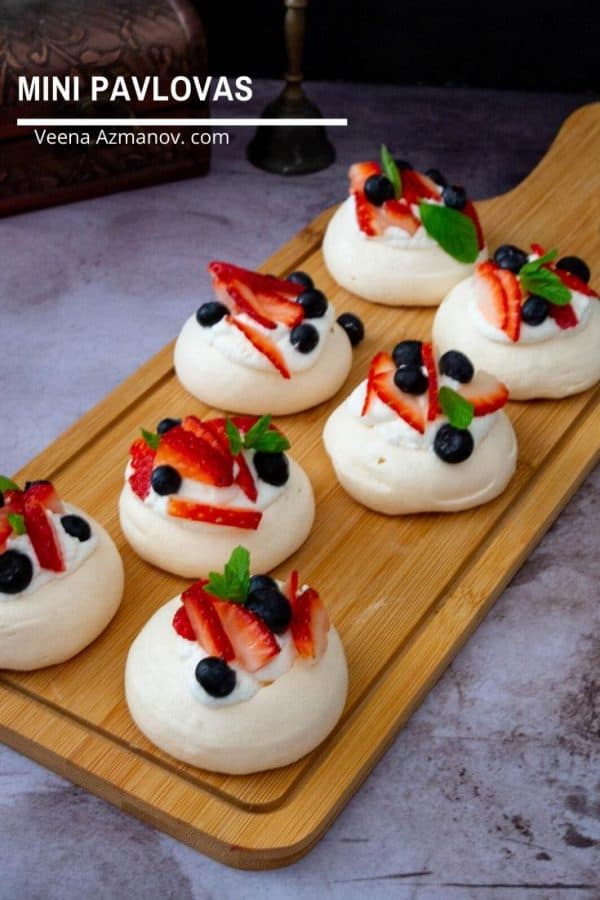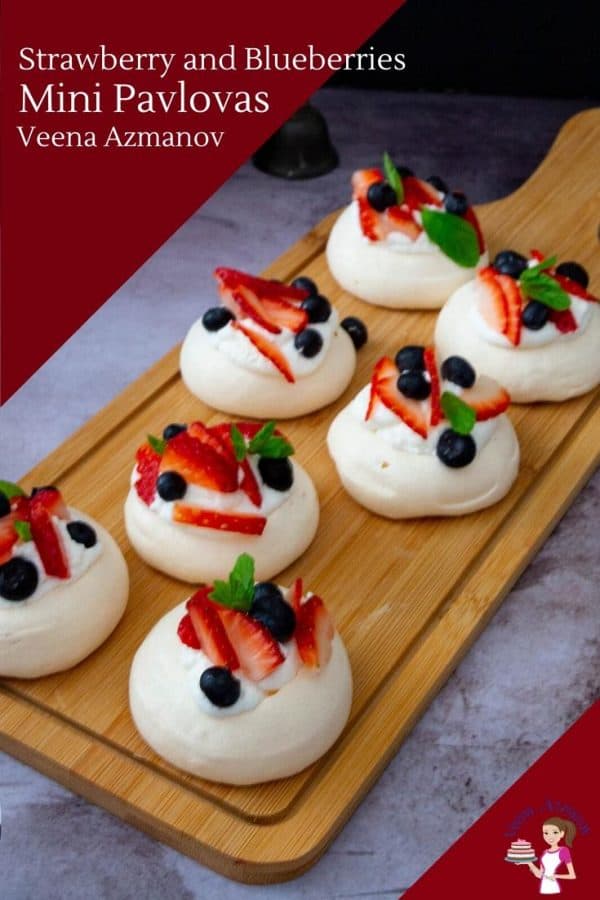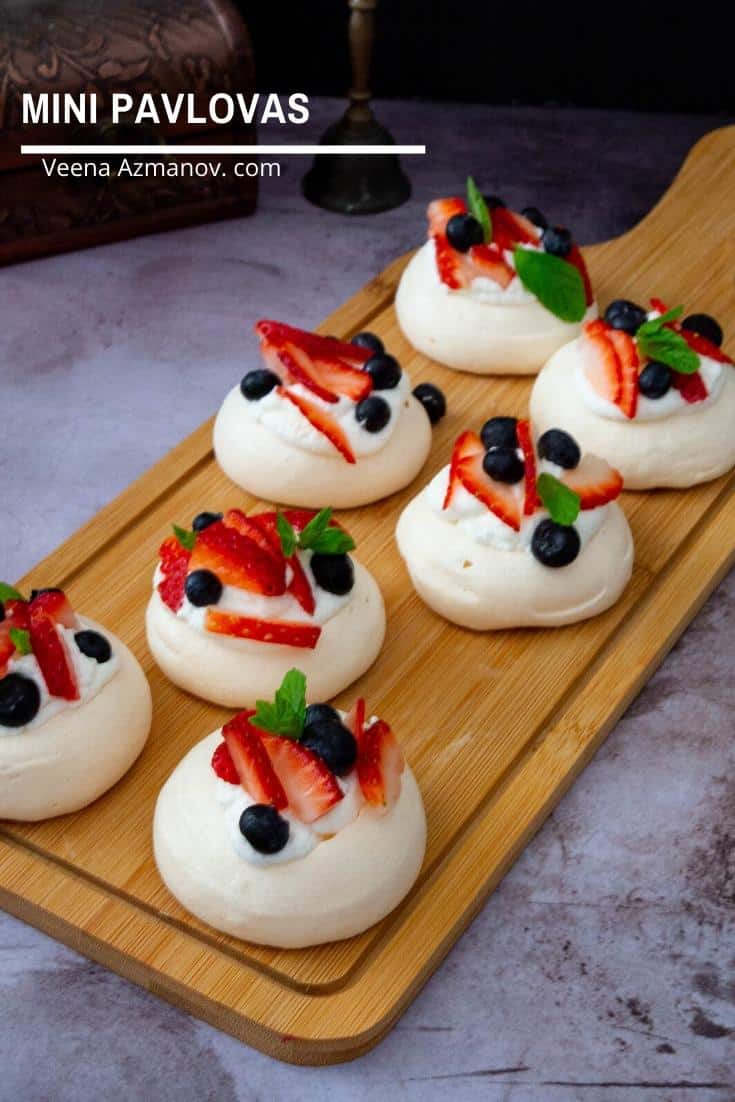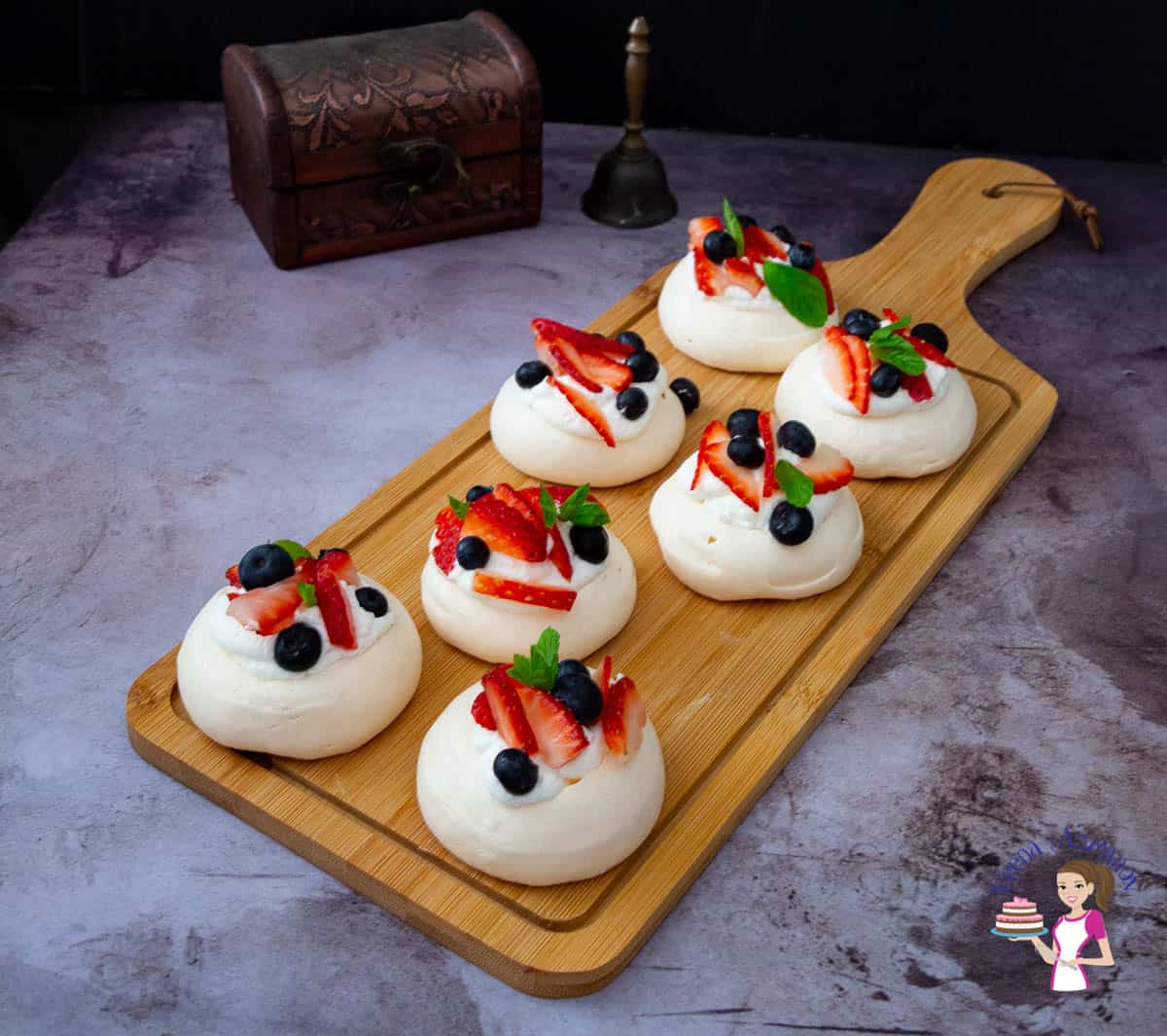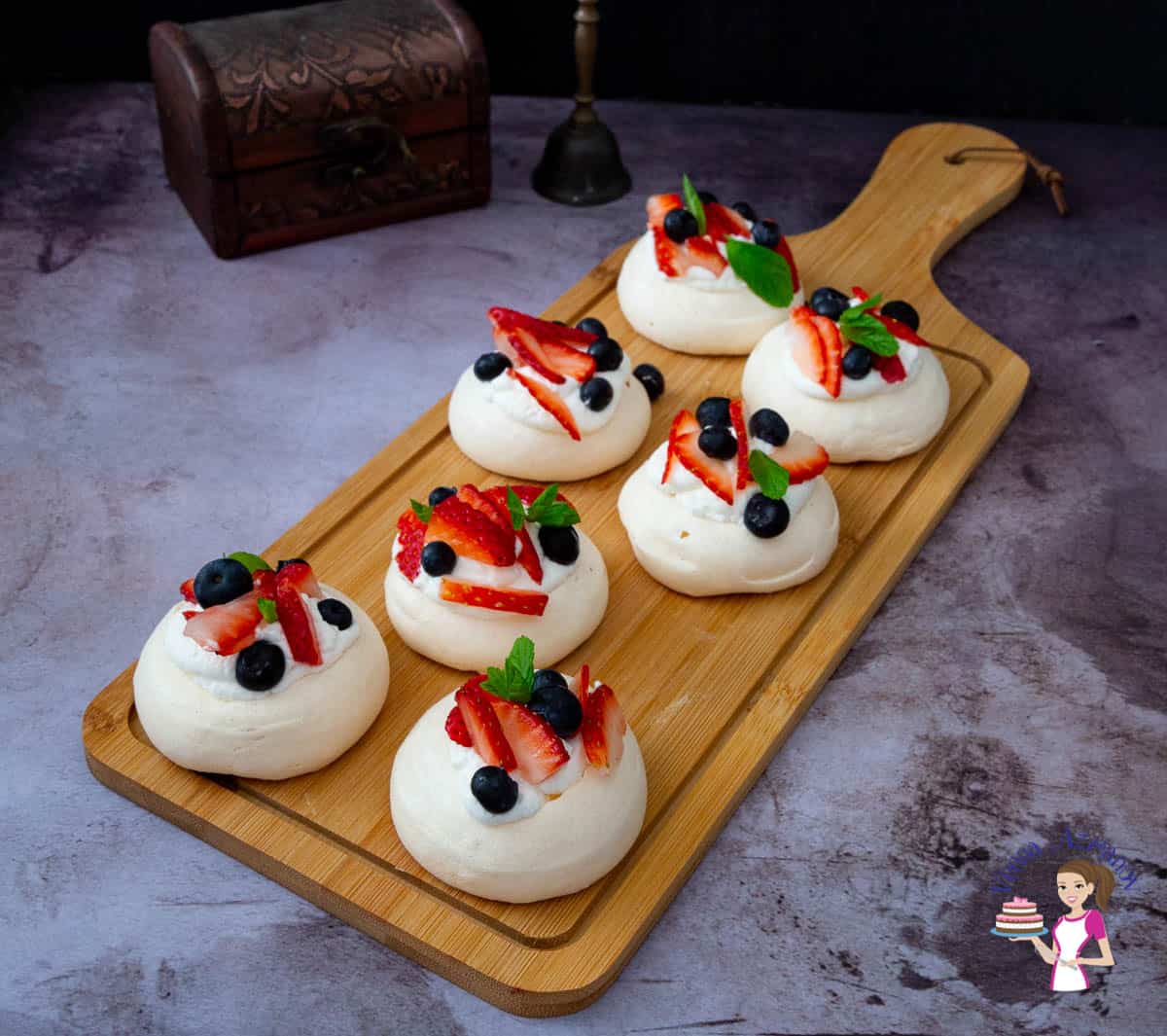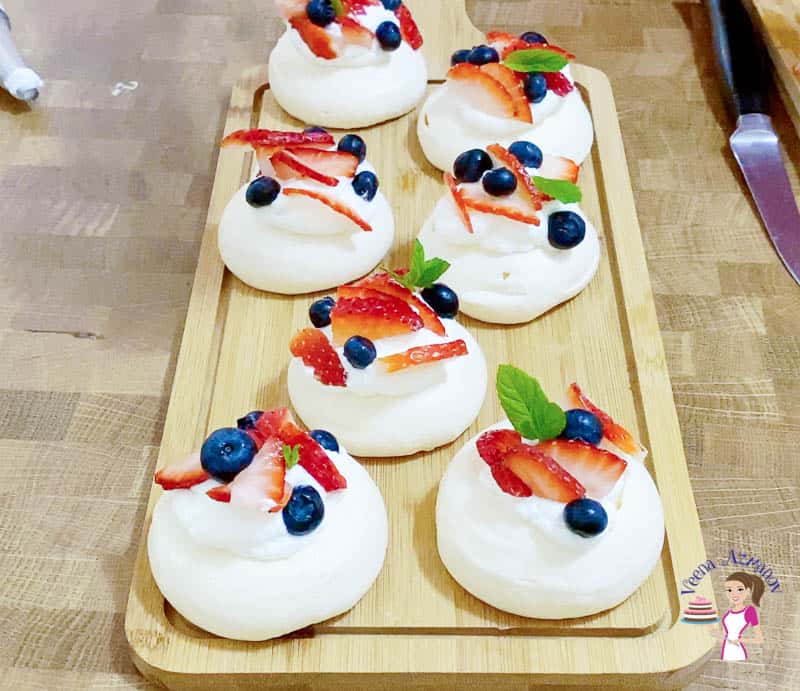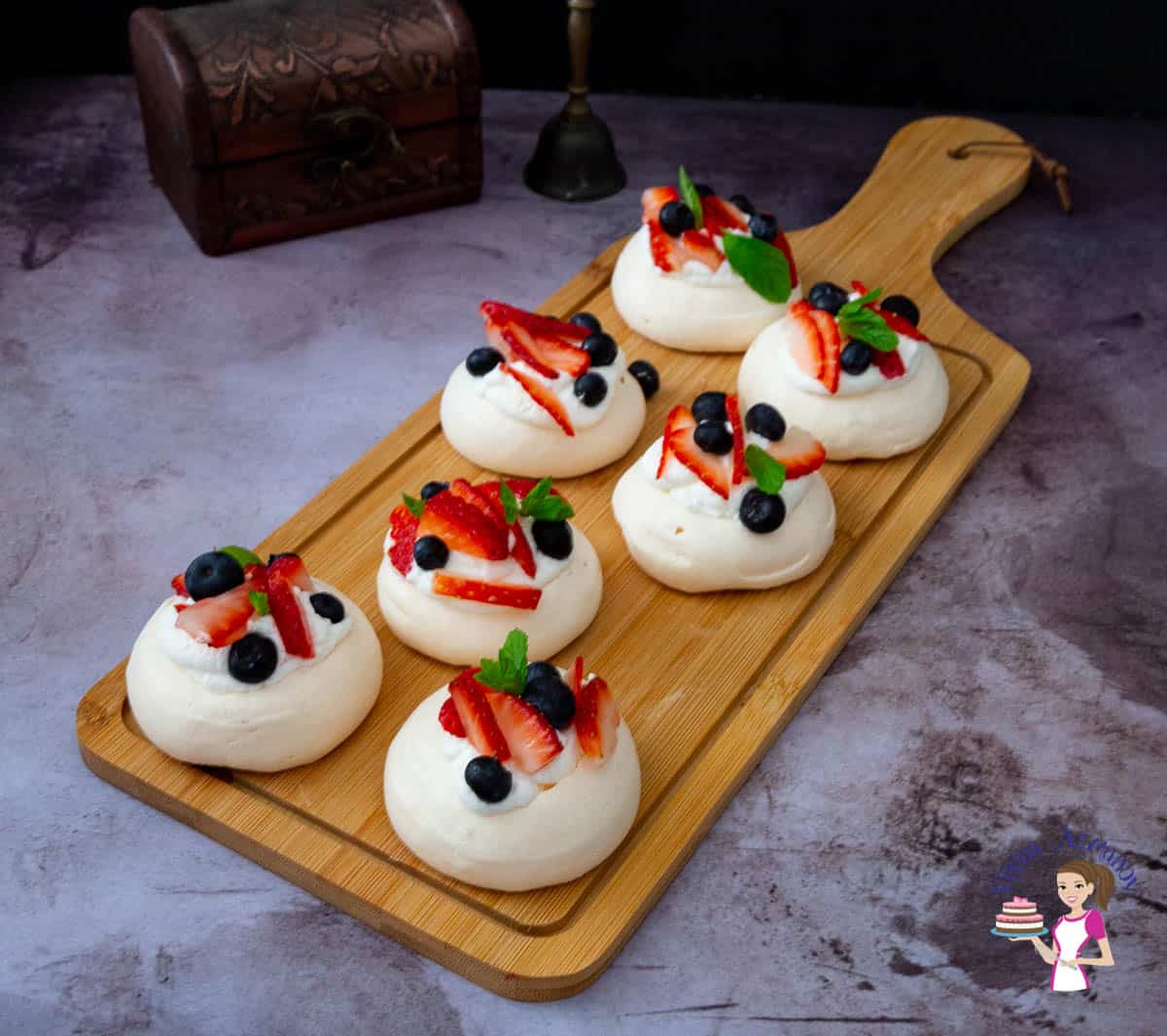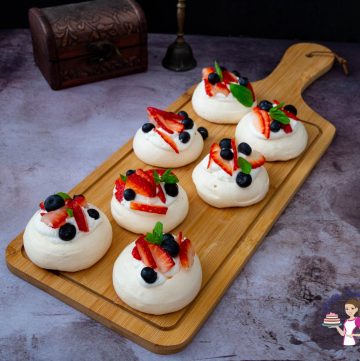Don’t these look adorable? I love individual desserts, especially when I have guests. That way I don’t have to cut and serve a large cake or pavlova. Although, I must admit there is also something so pretty about a large pavlova. Have you tried my raspberry pavlova ice cream yet?
About these mini pavlovas
If you’ve made a meringue, then you will love making a pavlova. Pavlova is basically a baked meringue. There are a few things you must take into consideration, which I have listed in the tips below. But other than that, this is a very simple and easy recipe to make. Every time I have spare egg whites, I make either meringue or pavlovas. It’s the perfect make-ahead kinda dessert to plan in advance. Also, it’s gluten-free, very light, and refreshing. The timeline for making a pavlova is:
Whip meringue – 10 minsBake pavlova – 30 minutesCool pavlova – 3 hours Assemble – 20 minutes
Ingredients and substitutes
Egg whites – Use large egg whites at room temperature. Room temperature eggs ensure you get a good volume when beating. Aged eggs are considered the best for pavlova. So, if you have old egg whites (without any yolk) use them. Tip – cold eggs are easier to separate. So separate them when cold but let them thaw before using. Sugar – Always use fine-grain white sugar when making a pavlova. This will ensure the sugar dissolves properly without leaving any grainy effect. Apart from that, sugar also stabilizes the egg whites helping them build volume and stay puffed up. How sugar affects baking.Cream of tartar – Gives a much creamier egg white and it prevents the separation of protein and water in the whites. It’s also flavorless, so it does not affect the flavor of your baked goods. The best substitute for cream of tartar is a pinch of salt, but lemon juice and vinegar are often used.Cornstarch – Absorbs any excess liquid left in your meringue so you have a nice crisp outside crust and a soft dry marshmallow on the inside without any weeping.
Step by step instructions
For the pavlova
Preheat the oven to 150 C / 300 F.Note – this temperature will change as soon as you place the pavlova into the oven.Line a baking tray with parchment paper. Set aside until ready to use.In the bowl of a stand mixer with the whisk attachment – add the egg whites and salt.Whip on medium speed for a minute then gradually add the sugar one tablespoon at a timeTip – adding the sugar slowly prevents the protein from drying out. Adding sugar quickly can cause the meringue to become flat and runny later too.When all the sugar has been added – continue to whip the meringue until you have stiff peaks.Tip – the meringue should be sticky with stiff peaks but still have a shiny appearance.Switch to a spatula – fold in the vanilla. Then sift in the cream of tartar and cornstarch.Tip – Cream of tartar helps stabilizes the protein in the meringue and prevents it from separating. The cornstarch absorbs all the excess moisture and gives a crisp meringue
Transfer the meringue to a piping bag with a large round piping tip.Pipe big dollops of meringue on to on a baking tray with parchment paper. You should get about 10 to 12 mini pavlovas depending on how big you pipe the meringuePlace the pavlovas in the oven on the center rack.Close the oven door and immediately reduce the oven temperature to 130 C / 265 F (DO NOT OPEN THE OVEN DOOR DURING BAKING).Bake for 35 minutes – when the baking time is done do not open the door, let the pavlovas cool inside the oven naturally.Tip – You can leave it in the oven for 2 to 3 hours up to 12 hours.
Assemble
Whip the whipping cream with confectioners sugar. And chop the fruitsUse an offset spatula to gently loosen the pavlova from the parchment paper.Place the pavlovas on a serving platter or cake board.Tip – once you assemble these, they are delicate to move around so always assemble them on a serving platter and not too early as the moisture from the whipping cream will make them softEvenly spread or pipe the whipped cream on each pavlova. Arrange the fruits of your choice. I’m using sliced strawberries, fresh blueberries, and mint leaves for garnish.
Frequently asked questions
What is a pavlova?
I say a pavlova is where the meringue and marshmallow come together as one. Yes, a pavlova is a baked meringue resulting in a sweet sugary crisp meringue-like outside with a sweet marshmallowy-like pillow inside.
What is the difference between a meringue and pavlova?
Both are made of egg whites and sugar. In a meringue, egg whites are whipped to stiff peaks. While for a pavlova, you take a whipped meringue, add cornflour and vinegar and then bake it low and slow. So pavlova is essentially a baked meringue.
What fruits work best for a pavlova?
A pav is quite sweet because it’s basically egg whites and sugar. To that, we add whipped cream which is light and refreshing, and yet also sweet. Therefore, I like to use fruits that are slightly tart or sour along with sweet. Strawberries, kiwis, blueberries, blackberries, as well as lemon and passion fruit work best. Since they help cut down the sweetness.
Troubleshooting
Why is my pavlova cracking?
A baked meringue when cooled always has cracks. This is normal. When baking a pavlova it is always recommended to cool it in the oven even after you switch the oven off. This cools it gradually, as the oven temperature gets lower, resulting in fewer cracks. And yet, there will still be cracks and this is normal.
Why is my pavlova soft in the middle?
The baked pavlova is supposed to be spongy like marshmallow but dry. As long as it’s dry, not wet, it is normal. One way to ensure the center is always cooked is to create a little dip in the center when shaping the meringue on the tray.
Why is my pavlova weeping?
Undissolved sugar in whipped egg whites can cause weeping. That is why it is recommended to use extra-fine sugar for meringue. The purpose of the cornstarch in the recipe is to absorb excess moisture from the egg whites. However, if there is too much-undissolved sugar the meringue will weep.
Why is my pavlova runny?
It is always recommended to use extra fine sugar and add it to whipping meringue slowly (one tablespoon at a time). Adding sugar quickly causes the meringue to become flat and runny. Even if the meringue does whip it has the tendency to collapse and become runny.
You may also like
Did you LIKE this recipe? Save it for later. You can find my recipes on Pinterest. Follow me on Facebook, Twitter, and Instagram.Subscribe, and I’ll send you new recipes right to your inbox.
Thank you for sharing - Save for later
